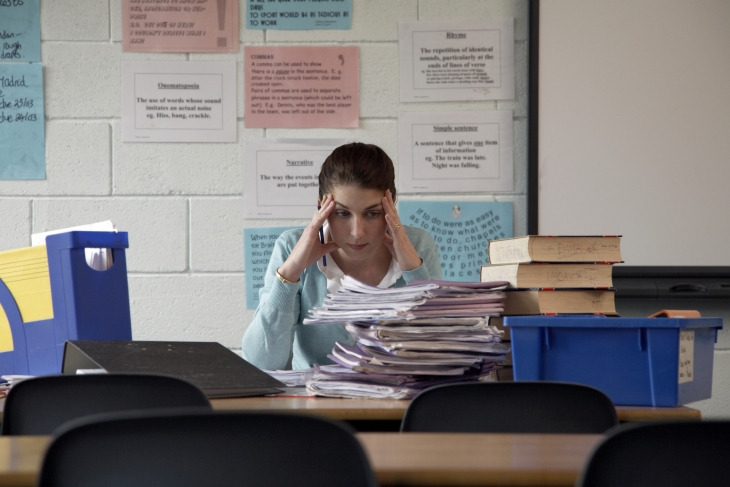Last week, I did something unorthodox. I asked teachers to message me directly via X (formerly known as Twitter) to vent their frustrations. Within hours, I received almost 200 messages expressing not only frustration, but also hope, humor, fatalism, and quite a bit of hesitancy to converse with a complete stranger on the internet. Without a doubt, these messages represent a very thin slice of the teaching workforce, but a thin slice supplies at least a taste of the whole pie.
Responses ranged from expected complaints about low pay to idiosyncratic observations about processed school breakfasts. Teachers have a lot on their minds. That few mentioned politics surprised me. Considering I aimed my invitation to conservative teachers specifically, I expected laments over liberal dogma and progressive pieties to abound. And certainly, some teachers mentioned such things, but these were a minority.
Instead, one theme surfaced over and again, illustrated by these two examples:
- “Our school isn’t safe. The energy in the hallways feels like something is going to happen at any moment. Fights are constant with little consequence.”
- “We allow behavior that would not be acceptable in any public square. Teachers are cussed out, threatened, disrespected with no consequences. The general public doesn’t understand the crisis we are in. It’s embarrassing. It’s tragic.”
After hours spent reading through these lamentations and conversing with some of the teachers who sent them, it seems there’s a deeper issue here than a mere lack of consequences. Students lack accountability of any kind. Teachers face an ever-mounting list of responsibilities and pressures, while students face ever fewer.
Lenient grading was the second most common complaint. Teachers cannot assign failing grades, administer penalties for late work, or grade students’ homework. Districts adopt these policies with good intentions, of course, including trying to be understanding of students from difficult backgrounds. And surely, some students run afoul of these standards because they’re from abusive homes or have unfair disadvantages such as learning English as their second language.
But many students failed to read their assigned passage of Shakespeare or finish their math homework because they were too busy playing Call of Duty and eating Cheetos with their friends. Kids will generally try to meet a standard to which we hold them accountable. If they’re allowed to turn in work late or complete half of assignments, that’s precisely what they’ll do.
Meanwhile, many teachers complained to me of the increased work load that these lenient policies have created for them. Administration expects endless communications with parents, an infinite number of differentiated tasks, and copious record keeping to justify every failing grade. At semester’s end, if that teacher still feels like assigning an F, one question invariably crops up: What could the teacher have done to prevent this failure? The student bears no culpability.
This dynamic is all the more pronounced regarding behavior. If a teacher hopes administration will assign a detention after their student cussed them out, they face a barrage of questions: Have they documented sufficient low-level disruptions to warrant a consequence? How many times have they communicated with parents? Had they built relationships? Is their class engaging enough or the material “relevant” to the student? Had they sweat enough while struggling to engage all 150 of their students?
Teachers faced accountability while students faced none. What had the teacher done or not done to foster misbehavior? Never was a student responsible for rudeness or an administrator for ineffective systems. And don’t even think about kicking the hornet’s nest of parental responsibility.
Throughout the messages, many teachers complained less about student behavior itself than the fault that was implicitly placed on them. They all expect children to misbehave. It’s in the job description. That’s not the point, even. What frustrated them most was being blamed for scenarios that weren’t their fault.
I can relate. One day before school started, one of my students caught word that another had spread a rumor about her on the bus. She ran out of my room to accost the gossiper. In follow-up conversations, administration castigated, not the students, but myself and the other teacher for supposedly allowing this dynamic. Administration assigned no consequence to either student, implicitly communicating to them—and their parents—that we adults were at fault, not the kids.
Recently, the Hechinger Report ran a misguided criticism of the ambiguity of common referral codes such as “insubordination” or “disrespect.” Suspensions must be reserved for only the most serious of infractions, the argument runs. The authors overlook how a consequence for “talking” often means that this student has talked out of turn many times, received detention or parent meetings previously, provides a contemptuous snort when a teacher tries to correct the behavior, and leaves a class difficult to both teach and learn in.
One teacher mentioned how such leniency “has created a spiraling, out-of-control situation in my building. Students consider themselves to be the authority. I have been called more names and gotten more threats this year than the previous twenty-six.” Permitting insubordination is the mold in the foundation that causes school culture to collapse. If administrators focus exclusively on significant misbehavior, they’ll impotently rebuild crumbling walls while the foundation continues to rot.
Permitting low-level defiance—defining deviancy down in this way—facilitates and fosters more severe misbehavior. If a student comes to learn that adults can be ignored and rules flaunted, behavior escalates. A balled piece of paper is thrown, a teacher asks the offender to move seats, but he refuses. The next day, he’s wandering around the classroom singing. The teacher asks him to sit, but he refuses. Eventually, he’s wandering the halls, telling teachers to “fuck off” if they ask him to return to class, so most don’t. Many other students have joined in the fun, and now there’s cacophony in the halls. Students in class question why they must listen to adults if they don’t want to when other kids get to flaunt the rules. Rowdy, unmonitored halls mean more chances for student conflict and fights.
Another teacher I spoke to finally quit after getting hurt “trying to break up a fight” only to find the perpetrator “was back in class the next day along with the boy she fought.” There are still consequences in schools without discipline, but staff and behaving children have to bear them.
Conversely, in one violent school, I had a stand-in assistant principal, who pressed for clear hallways and timely class attendance. When fights in the lunchroom, tanking reading scores, and chaotic classrooms called for attention, he focused entirely on attendance. It may have seemed like there were bigger fish to fry, but when we concentrated on attendance, the very culture of the school began to change. When the bell for class rang, administrators patrolled every hall and sent every tardy student to our building’s theater to check in. Three tardies earned a suspension, and rowdiness in the suspension room got them kicked out for the day. (I’m sure they complained about being kicked out for “talking.”)
Quickly, other areas of school began to change. When teachers could begin in a timely fashion, classrooms developed smoother routines. When the hallways were clear, it changed the atmosphere inside and outside classrooms. This was no longer a place for play but one for learning. Students who usually spent hours ambling the hallways attended class, developed new goals, rubbed shoulders with their more academically-minded peers, and developed relationships with teachers. Unfortunately, this administrator was only with us for a short time. His replacement lectured us about the ambiguity of “insubordination,” and the school returned to chaos.
Fundamentally, our efforts to understand the various systemic causes of misbehavior—insufficient food, weak parental guidance, cultural conflict—strips students of agency. It allows them much liberality, yes—it seems they can do whatever they damn well please—but imbues them with no empowerment or sense of control as self-willed agents. All of their actions have external causes. They are particles bouncing around with no power to act or choose for themselves.
Conversely, consequences and accountability communicate something important to students: They have the power to succeed or fail, they have the agency to choose right and wrong, and with their actions, they can better themselves and rise above their circumstances. Holding a child to account is an empowering act.
I began this column sympathetic to teachers, and still am, but by its conclusion I almost pity the students more. Everything a school does communicates implicit messages to them. Right now, schools tell too many students that their ZIP code is in fact their destiny, that the adults in their lives expect nothing better from them, and that they’re powerless to change their life for the better.
It’s fatalistic. It’s nihilistic. It’s unethical. And it’s creating an education system that’s unsustainable for teachers and failing our students.




